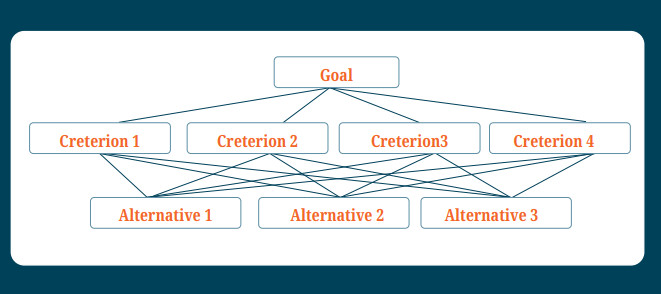
What is AHP?
Analytic Hierarchy Process (AHP) is one of the multi-objective decision-making methods, proposed by Thomas L. Saaty- a mathematician from Iraq. AHP is a quantitative method, used to sort decision alternatives and select one that satisfies given criteria. Based on the principle of pair comparison, the AHP method can be described by the three main principles: analysis, evaluation and synthesis.
Steps to implement this method can be summarized as follows. First, AHP analyzes a complex, multi-criteria problem in a hierarchy structure. The hierarchy structure diagram begins with a decision problem (goal), which is analyzed based on a number of large criteria and component criteria, the final hierarchy often includes possible alternatives that can be compared and chosen.
Then, criteria are prioritized, usually on a scale from 1 to 9 through a pairwise comparison. Next, calculate the numerical criteria and calculate the priority of the alternatives according to each criterion and at the same time, consistency ratio is checked to ensure appropriate reliability. Finally, scoring for alternatives, all numbers are summed up to make the best decision.
AHP method has been proposed to be used quite widely to solve economic, political, social and engineering design problems as choosing architectural patterns, formulating pricing strategies, marketing strategies, etc. technology selection. In the field of administration, it is also a tool for planning, conflict resolution, benefit/cost analysis, and resource allocation.

Applying AHP in current supply chain management
The implementation of social distancing on a local or regional scale during the COVID-19 pandemic can lead to inadequate consequences, even disruption of the supply chain of food or essential goods for people. In order to control the spread of the disease, sometimes localities are forced to make decisions to limit travel, which can lead to the situation that the market and supermarket system are out of stock, or have stock but they cannot reach consumers; people’s needs are not met in time, while farmers and producers cannot sell goods.
In supply chain management, AHP has been widely applied in decisions to choose best suppliers. In addition to common criteria such as price, quality, delivery time, flexibility, environmental factors, risks and logistics are also analyzed. AHP is also used in distribution to locate a warehouse (involving minimizing costs that include initial investment, materials, labor, and inventory while maximizing location benefits) and multiple warehouses (considering the production-distribution network so that transportation costs are lowest, while meeting special requirements from customers).
In the current context, it is possible to set up a dual goal of ensuring the supply chain of food and essential goods for the people, while still ensuring distancing measures to control the epidemic. To ensure that goal, it is necessary to define criteria related to the fields of economy, society, technology - environment... on the basis of analyzing the actual situation and the expected level of the components. For example, the criteria could be related to intercity transport; supplydemand balance; degree of opening of markets, shops and supermarkets; shipper; technology solutions; price stabilization… The solutions can be expected based on the degree of “openness” or “tightening” of the solution groups related to the supply chain. The detailed implementation of these steps, along with subsequent steps in the application of AHP such as comparing pairs of criteria and determining weights for criteria, comparing pairs of alternatives, and determining the weights of methods to choose the optimal solution belongs to the professional work of the consultants and is not included in the content of this article.
The above is just a suggestion to illustrate a simple selection and decision-making problem with a small number of criteria. When there are multiple comparison criteria, specialized software such as Expert Choice can be used or in combination with another method such as Analytical Network Process (ANP). AHP analysis can be laborious because of the principle of pairwise comparison and consistency factor checking. When the coefficient of consistency exceeds the limit, it is necessary to review and revise the assessment table. Therefore, the factors should be presented in the panel of experts to remove the less important factors before applying AHP.







.png)
.png)






